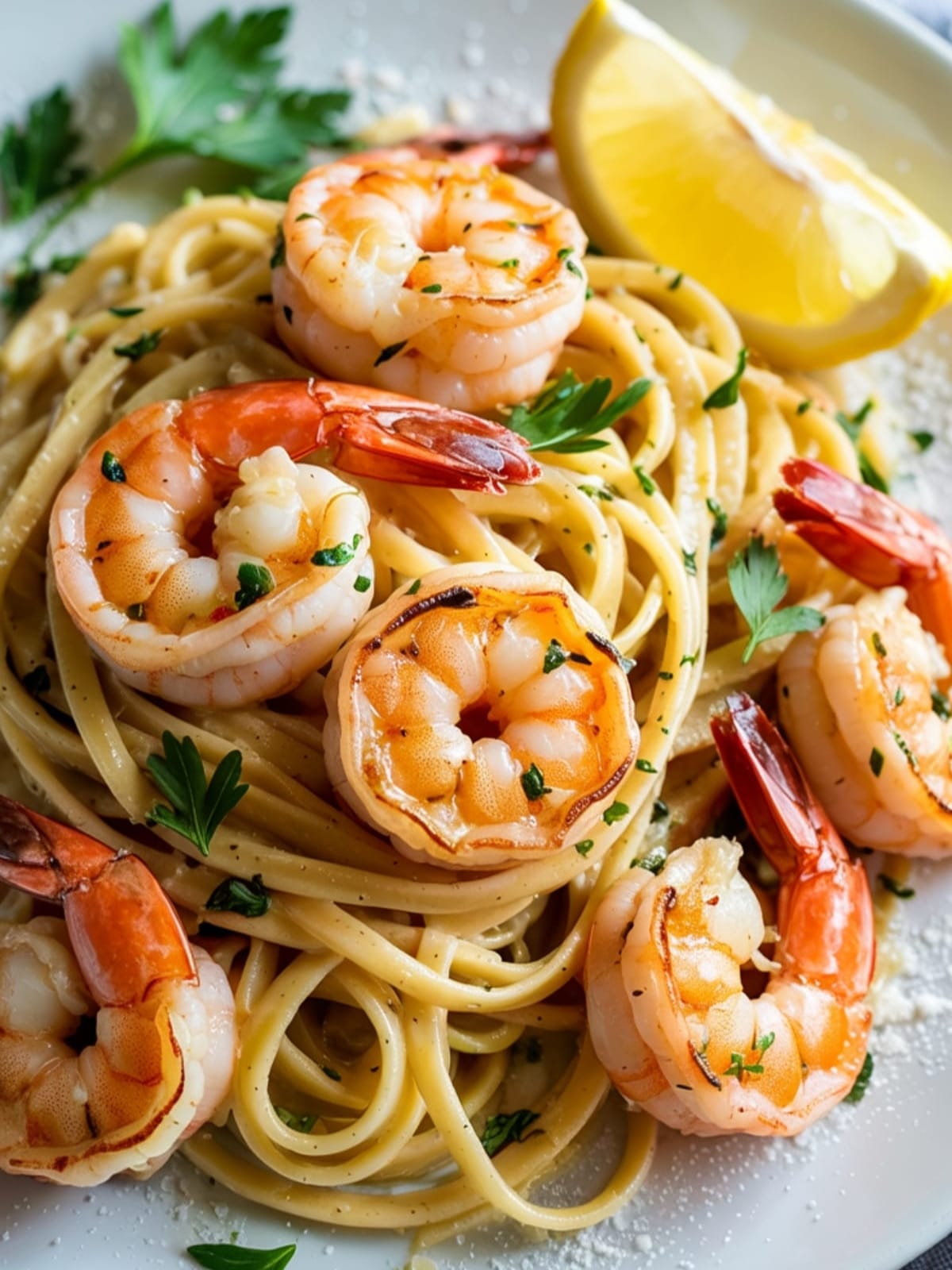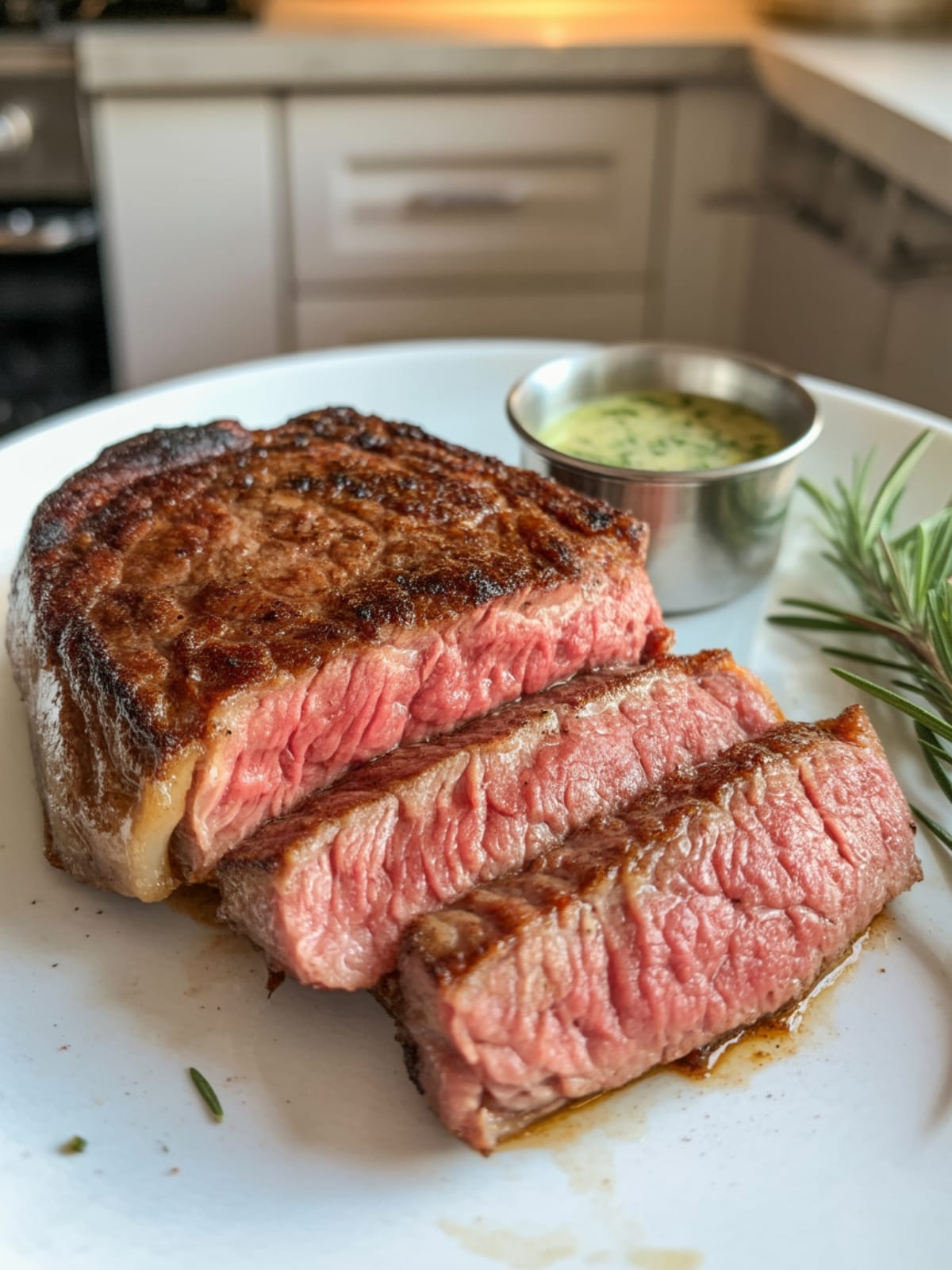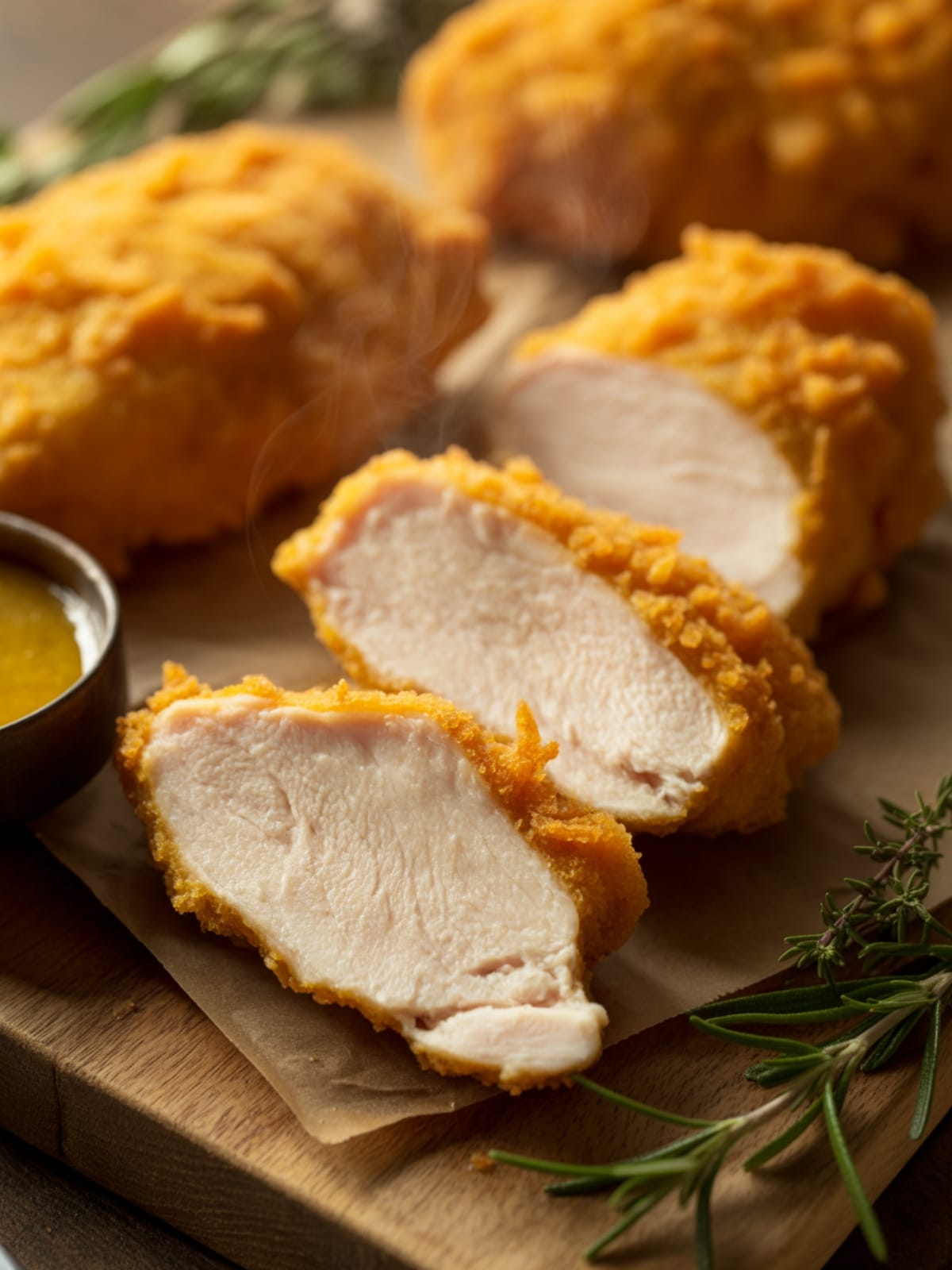Ever had one of those days when you want dinner to taste like you spent hours in the kitchen, but you actually have the energy of a sloth on vacation? Enter: Garlic Butter Shrimp Pasta. This dish is basically culinary sleight-of-hand—it looks fancy, tastes amazing, and comes together so quickly that you’ll have time to pretend you’ve been slaving away all afternoon. Just muss your hair a bit before serving for added effect.
Why This Recipe is Awesome
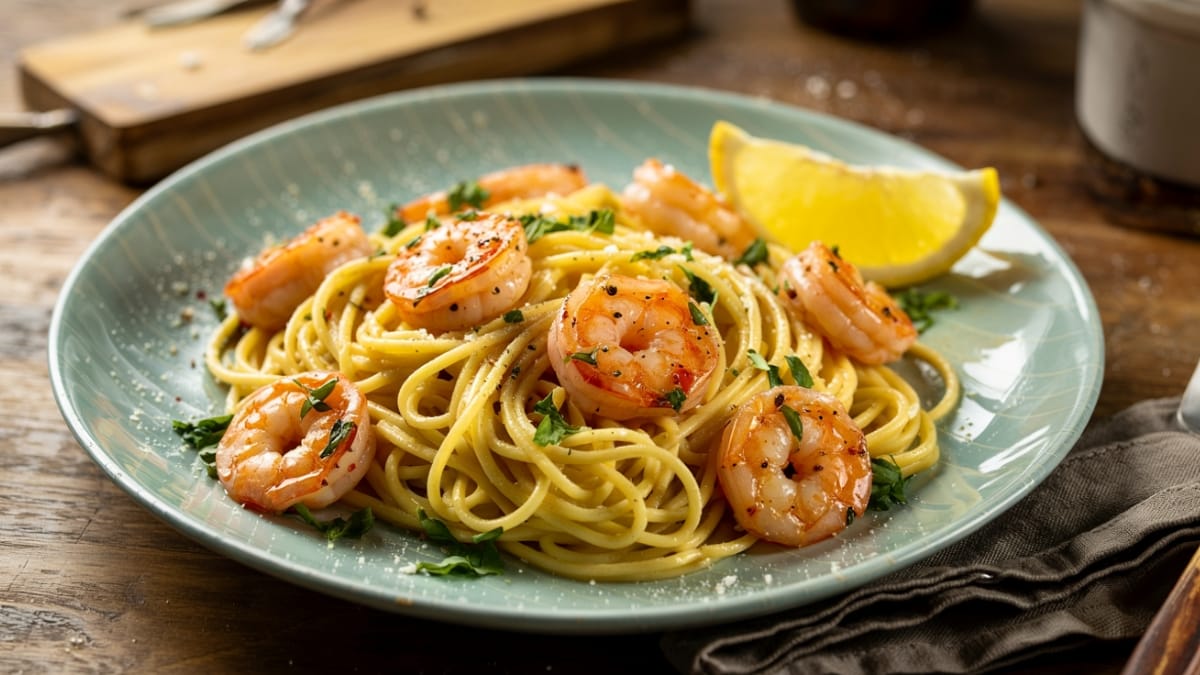
This Garlic Butter Shrimp Pasta isn’t just dinner—it’s a lifesaver disguised as a meal. It’s the perfect combination of “impressive enough for company” and “easy enough for a Tuesday night when your brain has left the building.”
The sauce is a thing of beauty: garlicky, buttery, with just enough lemon to cut through the richness. It clings to the pasta in that perfect way that makes you want to twirl every strand on your fork.
What I love most about this recipe is that it uses simple ingredients that transform into something that tastes like it came from that Italian restaurant where they sing opera while you eat. The one where a plate of pasta costs half your paycheck. Except this version costs a fraction and won’t include awkward tableside serenading.
Plus, it’s endlessly customizable. Need it creamier? Done. Want to add veggies? Go for it. Feeling fancy? Throw in some wine. It’s like the Choose Your Own Adventure of pasta dishes.
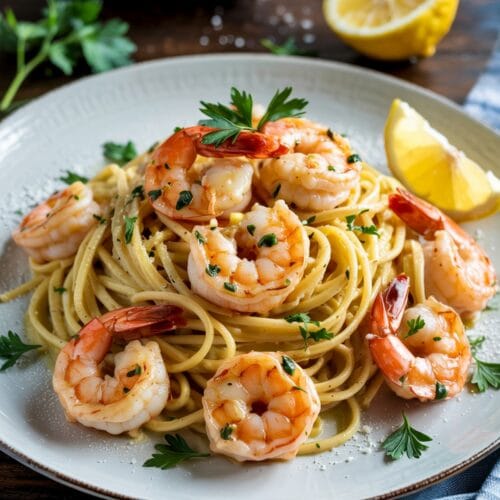
Garlic Butter Shrimp Pasta
Ingredients
- 8 oz linguine or spaghetti about half a box
- 1 pound large shrimp peeled and deveined
- 4 tablespoons unsalted butter divided
- 4 tablespoons olive oil divided
- 6 cloves garlic minced (yes, SIX—we’re not playing around here)
- 1/4 teaspoon red pepper flakes adjust to your spice preference
- 1/2 cup dry white wine or chicken broth if you’re saving your wine for drinking
- Juice of 1 lemon
- Zest of 1/2 lemon
- 1/4 cup fresh parsley chopped
- 1/2 cup grated Parmesan cheese plus more for serving
- Salt and freshly ground black pepper to taste
- Optional: 1/4 cup heavy cream for a creamier sauce
Instructions
- Bring a large pot of water to a boil. Add a generous amount of salt (it should taste like seawater) and cook the pasta according to package directions until al dente. Before draining, reserve 1 cup of pasta water—this starchy liquid is liquid gold for your sauce.
- While the pasta cooks, prep your shrimp. Pat them dry with paper towels (wet shrimp = sad, steamed shrimp instead of nicely seared ones). Season with salt and pepper.
- Heat your showtime skillet. In a large skillet over medium-high heat, add 2 tablespoons of butter and 2 tablespoons of olive oil. When the butter starts to foam but before it browns, add the shrimp in a single layer.
- Cook those shrimp perfectly. Let them sear for about 1-2 minutes per side until they're pink and opaque. Don't overcook them unless you enjoy the texture of rubber bands. Remove to a plate and set aside.
- Create flavor town. In the same skillet, reduce heat to medium and add the remaining 2 tablespoons each of butter and olive oil. Add the minced garlic and red pepper flakes, stirring constantly for about 30 seconds until fragrant but not browned. Burned garlic will ruin your day faster than stepping on a Lego.
- Deglaze like a pro. Pour in the white wine (or broth) and use a wooden spoon to scrape up all the delicious browned bits from the bottom of the pan. Let it reduce by half, about 2-3 minutes.
- Add the brightness. Stir in the lemon juice and zest. If going for the creamy version, add the heavy cream now and let it simmer for a minute.
- Bring it all together. Add the drained pasta directly to the sauce in the skillet. Toss well to coat, adding splashes of that reserved pasta water as needed to create a silky sauce that clings to the pasta. Start with a little—you can always add more.
- Return the shrimp to the skillet along with any accumulated juices (flavor!). Add the Parmesan cheese and parsley, tossing gently to combine. Taste and adjust seasoning with salt and pepper.
- Serve immediately with extra Parmesan, a sprinkle of parsley, and some fresh cracked pepper. Twirl that fork and prepare for compliments.
Notes
- Timing is everything with this dish. Have all your ingredients prepped and ready to go before starting to cook.
- The reserved pasta water is crucial for achieving that silky sauce texture. Don’t skip this step!
- For a richer flavor, try using half butter and half extra virgin olive oil.
- Shrimp size matters. Large or extra-large shrimp (16-20 per pound) work best in this dish.
- If using frozen shrimp, thaw completely and pat dry before cooking.
- The pasta will continue to absorb sauce as it sits, so serve promptly for the best texture.
- Leftover pasta? Reheat gently with a splash of water or broth to revive the sauce.
Calories & Nutritional Info
- Calories: Approximately 500 per serving (without cream)
- Protein: 30g
- Fat: 25g
- Carbs: 35g
- Fiber: 2g
- Sodium: 890mg (varies depending on how much salt you add)
- Cholesterol: 185mg
- Calcium: 15% DV (more with added Parmesan)
- Iron: 20% DV
Common Mistakes to Avoid
- Overcooking the shrimp. They continue cooking slightly from residual heat, so remove them from the pan just as they turn opaque.
- Not drying the shrimp properly. Wet shrimp will steam rather than sear, and you’ll miss out on that delicious caramelization.
- Burning the garlic. This happens in seconds and will give your dish a bitter taste. Keep the heat moderate and stir constantly.
- Skipping the pasta water. This starchy liquid is the secret to a smooth, cohesive sauce that clings to the pasta.
- Overcooking the pasta. Aim for al dente—it will continue to cook slightly when added to the hot sauce.
- Forgetting to season. Each component needs seasoning, including the pasta water and the shrimp.
- Adding cold cream directly to a hot pan. This can cause it to separate. Either bring the cream to room temperature first or reduce the heat before adding.
Alternatives & Substitutions
- Different pasta shapes: Angel hair works for a more delicate dish, while fettuccine or pappardelle stand up to a heartier sauce. Whole wheat or gluten-free pasta work too.
- No shrimp? Try scallops, chunks of firm white fish, or even chicken.
- Add vegetables: Spinach, cherry tomatoes, asparagus, or peas all make wonderful additions. Add them to the skillet before returning the shrimp.
- Herb variations: Basil, oregano, or thyme can replace or complement the parsley.
- Dairy-free version: Use all olive oil instead of butter and omit the Parmesan (or use a non-dairy alternative).
- Spice it up: Add more red pepper flakes, or try a dash of smoked paprika or Cajun seasoning.
- Creamy alternatives: Greek yogurt or mascarpone can substitute for heavy cream.
- Budget tip: Stretch the dish by using half the shrimp and adding cannellini beans.
FAQs
Can I use frozen shrimp?
Absolutely! Just make sure they’re completely thawed and patted dry before cooking. In fact, frozen shrimp are often fresher than “fresh” shrimp at the seafood counter, which have likely been thawed already.
What can I substitute for white wine?
Chicken or vegetable broth works well, with a splash of white wine vinegar or extra lemon juice for acidity. You could also use clam juice for a more seafood-forward flavor.
How do I know when the shrimp are perfectly cooked?
Shrimp cook very quickly and turn from gray and translucent to pink and opaque when done. They also curl into a loose “C” shape—if they curl into a tight “O,” they’re overcooked.
Can I make this ahead of time?
This dish is best freshly made, as the pasta continues to absorb sauce and the shrimp can become tough when reheated. If necessary, prepare the components separately and combine just before serving.
What side dishes go well with this pasta?
A simple green salad with a light vinaigrette makes a perfect counterpoint to the rich pasta. Garlic bread is always welcome, or try roasted vegetables for a more substantial meal.
How do I make the sauce creamier without using cream?
Start by adding more pasta water and butter, tossing vigorously to emulsify. Alternatively, you can add a splash of half-and-half or an extra handful of finely grated Parmesan.
Can I add wine if I don’t usually cook with alcohol?
The alcohol cooks off, leaving just the flavor. However, if you prefer not to use wine, chicken broth with a splash of lemon juice makes a great substitute.
Final Thoughts
This Garlic Butter Shrimp Pasta is proof that amazing food doesn’t have to be complicated or time-consuming. It’s the kind of recipe that combines everyday ingredients into something that feels special enough for celebrations but easy enough for those nights when cooking feels like climbing Mount Everest. Keep these ingredients on hand, and you’ll always be 20 minutes away from a dinner that’ll make everyone think you’ve got your life together—even if you’re secretly wearing pajama pants at the table.
